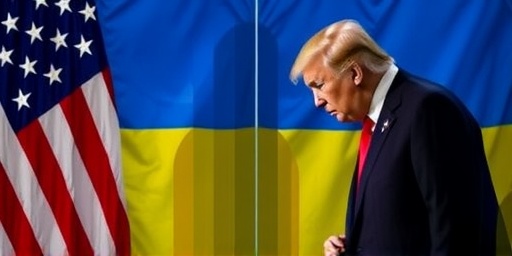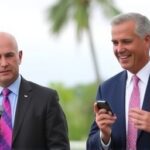In a bold and unprecedented move, US President Donald Trump has issued a stark ultimatum to Ukraine, demanding that the war-torn nation accept a US-backed peace proposal with Russia by November 27, or risk losing all American military and financial support. This deadline, announced during a fiery White House press briefing on Monday, places immense pressure on Ukrainian President Volodymyr Zelenskyy, who is already grappling with a spiraling domestic corruption scandal and the relentless grind of the ongoing conflict with Russia.
The proposal, hammered out in secretive backchannel talks between Trump administration officials and Russian counterparts, aims to end the nearly three-year war that has claimed over 500,000 lives and displaced millions. Trump, speaking to reporters, did not mince words: “Ukraine has one week to say yes to peace. If they don’t, America walks away. We’ve poured billions into this fight—it’s time for them to step up.” This aggressive stance marks a dramatic shift in US policy, potentially reshaping the geopolitical landscape of Eastern Europe.
Breaking Down the US-Russia Peace Proposal’s Key Terms
The peace proposal, leaked to major outlets like The New York Times and confirmed by anonymous sources close to the negotiations, outlines several contentious provisions designed to broker an immediate ceasefire. At its core, the plan calls for Ukraine to cede control of Crimea—annexed by Russia in 2014—and the Donbas region, where separatist forces backed by Moscow have held sway since 2014. In exchange, Russia would withdraw its troops from other occupied territories in eastern Ukraine and commit to a 10-year non-aggression pact.
Further details reveal economic incentives baked into the deal. The US has pledged $50 billion in reconstruction aid for Ukraine, contingent on acceptance, while Russia agrees to lift sanctions on Ukrainian grain exports, which have been crippled by the Black Sea blockade. “This isn’t just about borders; it’s about rebuilding lives,” said a senior Trump advisor, speaking on condition of anonymity. The proposal also includes demilitarization zones along the new borders, monitored by UN peacekeepers, and a provision for Ukraine to remain neutral, forgoing NATO membership aspirations for at least 20 years.
Critics, including European Union diplomats, argue that the terms heavily favor Russia, effectively rewarding Vladimir Putin’s invasion. According to a recent report from the Atlantic Council, Ukraine’s territorial losses under this plan would amount to 20% of its pre-2014 landmass, a bitter pill for a nation that has fought tooth and nail to preserve its sovereignty. Yet, proponents within the Trump circle highlight the proposal’s potential to save lives: the UN estimates that the war has resulted in 10,000 civilian deaths and left 6 million Ukrainians as refugees.
Zelenskyy’s Tightrope Walk Between War, Scandal, and US Pressure
Ukrainian President Volodymyr Zelenskyy finds himself at a crossroads, squeezed by Trump’s deadline on one side and a burgeoning corruption scandal at home on the other. Elected in 2019 on a promise to end the Donbas conflict and root out graft, Zelenskyy now faces allegations that his inner circle has siphoned off $400 million in Western aid intended for military procurement. The scandal erupted last week when Ukraine’s anti-corruption bureau raided offices in Kyiv, uncovering evidence of kickbacks involving US-supplied weapons.
“This is a moment of truth for Zelenskyy,” said Oksana Markarova, Ukraine’s former ambassador to the US, in an interview with CNN. “Accepting the peace proposal might stabilize the front lines but could fracture national unity. Rejecting it risks alienating the US, our biggest backer.” Public opinion polls from the Kyiv International Institute of Sociology show Zelenskyy’s approval rating dipping to 45%, the lowest since the invasion began in February 2022. Protests in Kyiv and Lviv have decried the corruption probe as a witch hunt, but others demand accountability amid reports that soldiers on the front lines lack basic supplies.
Zelenskyy’s response has been measured. In a televised address on Sunday, he acknowledged the proposal’s existence but stopped short of endorsement: “Ukraine will not surrender its future to ultimatums. We fight for every inch of our land, but peace must be just.” Behind the scenes, Zelenskyy has dispatched envoys to Washington for emergency talks, seeking concessions like guaranteed security pacts without territorial concessions. However, with Russian forces advancing in Kharkiv oblast—gaining 200 square kilometers in the past month—the urgency is palpable.
Russia’s Cautious Welcome and Putin’s Strategic Calculations
From the Kremlin, the reaction to Trump’s deadline has been one of guarded optimism. Russian President Vladimir Putin, who has long portrayed the war as a defensive response to NATO expansion, sees the US-backed peace proposal as a validation of Moscow’s territorial claims. In a statement released by the Russian Foreign Ministry, Putin praised the initiative as “a pragmatic step toward de-escalation,” while emphasizing that any deal must include recognition of Russia’s security concerns.
Analysts suggest Putin’s enthusiasm stems from battlefield realities. Despite mobilizing 300,000 additional troops earlier this year, Russia has suffered heavy losses—estimated at 120,000 soldiers killed or wounded by Western intelligence. The proposal allows Putin to claim victory without further escalation, preserving resources for potential future conflicts. “Trump’s approach aligns with Russia’s narrative that the West is war-weary,” noted Fiona Hill, a Russia expert at the Brookings Institution. “It’s a win for Putin if Ukraine folds under pressure.”
Yet, Russia isn’t without reservations. Kremlin insiders report that Putin is pushing for harsher terms, including reparations from Ukraine for alleged “crimes” in Donbas and veto power over Ukraine’s future alliances. Diplomatic cables obtained by Reuters indicate ongoing haggling, with Russia threatening to intensify drone strikes on Ukrainian infrastructure if the deadline passes without progress. As of Tuesday, Russian state media has ramped up propaganda portraying Zelenskyy as a puppet of Western interests, further complicating Ukraine’s domestic politics.
Global Ripples: Allies React to Trump’s High-Stakes Gamble
Trump’s ultimatum has sent shockwaves through international alliances, drawing sharp rebukes from NATO partners and cautious support from non-Western powers. UK Prime Minister Keir Starmer called the move “reckless,” warning that it could embolden authoritarian regimes worldwide. In a joint statement, the EU’s foreign ministers expressed “profound concern” over the proposal’s territorial concessions, pledging an additional €10 billion in aid to Ukraine regardless of the outcome.
China, a key Russian ally, has remained neutral but opportunistic. Beijing’s state broadcaster CCTV described the deadline as a “positive development for Eurasian stability,” hinting at potential Chinese mediation. Meanwhile, in the US Congress, bipartisan criticism is mounting. Senate Foreign Relations Committee Chair Bob Menendez (D-NJ) labeled it “a betrayal of democratic values,” while some Republicans, like Sen. Lindsey Graham (R-SC), have voiced tentative approval, citing the $113 billion in US aid spent since 2022 as unsustainable.
Economic markets are jittery too. The Ukrainian hryvnia plummeted 5% against the dollar following the announcement, and European natural gas prices spiked 8% amid fears of renewed Russian leverage. Experts from the International Monetary Fund warn that rejection of the proposal could tip Ukraine into default on its $150 billion debt, exacerbating global food insecurity as Ukraine’s wheat exports—vital for Africa and the Middle East—remain stalled.
Paths Forward: Ceasefire Hopes or Escalated Conflict?
As the November 27 deadline looms, the world watches with bated breath. If Ukraine accepts the peace proposal, it could usher in a fragile truce, allowing reconstruction and refugee returns, but at the cost of national pride and long-term security. Zelenskyy might leverage the moment to purge corrupt officials, bolstering his leadership, though hardline nationalists in parliament could force early elections.
Rejection, however, spells peril. Trump has hinted at redirecting aid to Israel and Taiwan, leaving Ukraine to rely on dwindling European support. Russian advances could accelerate, potentially encircling Odesa and severing Ukraine’s Black Sea access. International mediators, including UN Secretary-General António Guterres, are urging extensions, but Trump’s team insists the clock is ticking.
In the broader scheme, this gambit underscores Trump’s America First doctrine, prioritizing quick wins over multilateral consensus. For Zelenskyy, the choice is existential: peace on imposed terms or war without the West’s shield. As frontline reports describe intensified shelling in Zaporizhzhia, the human cost mounts, reminding all that deadlines are drawn in blood.









